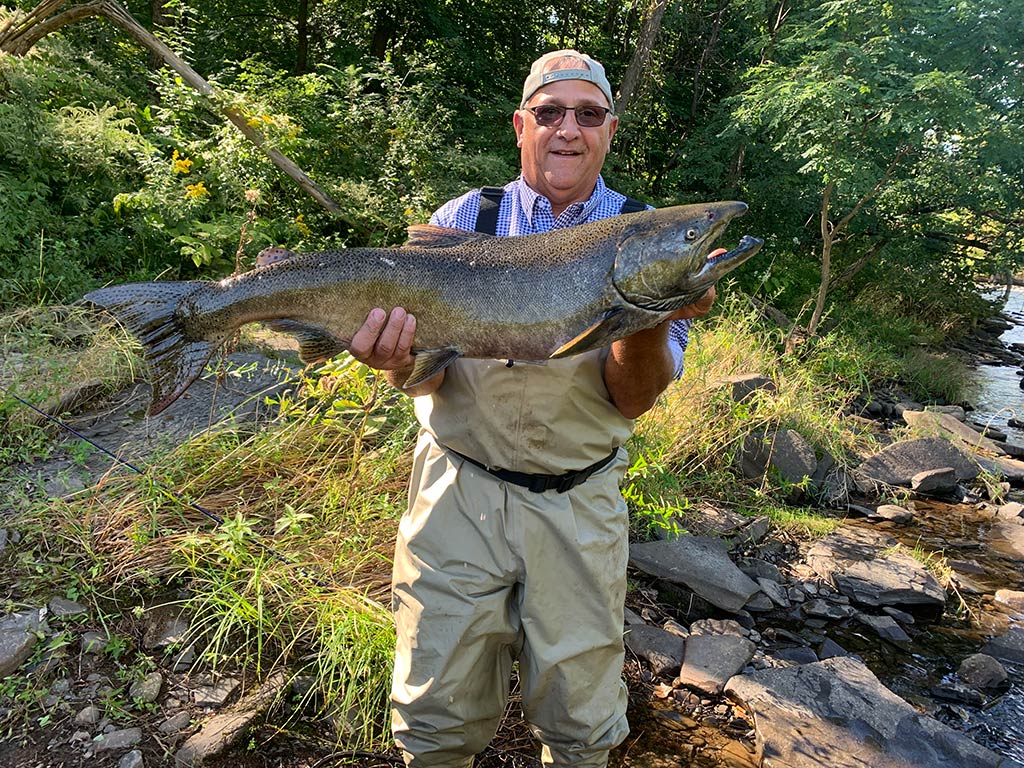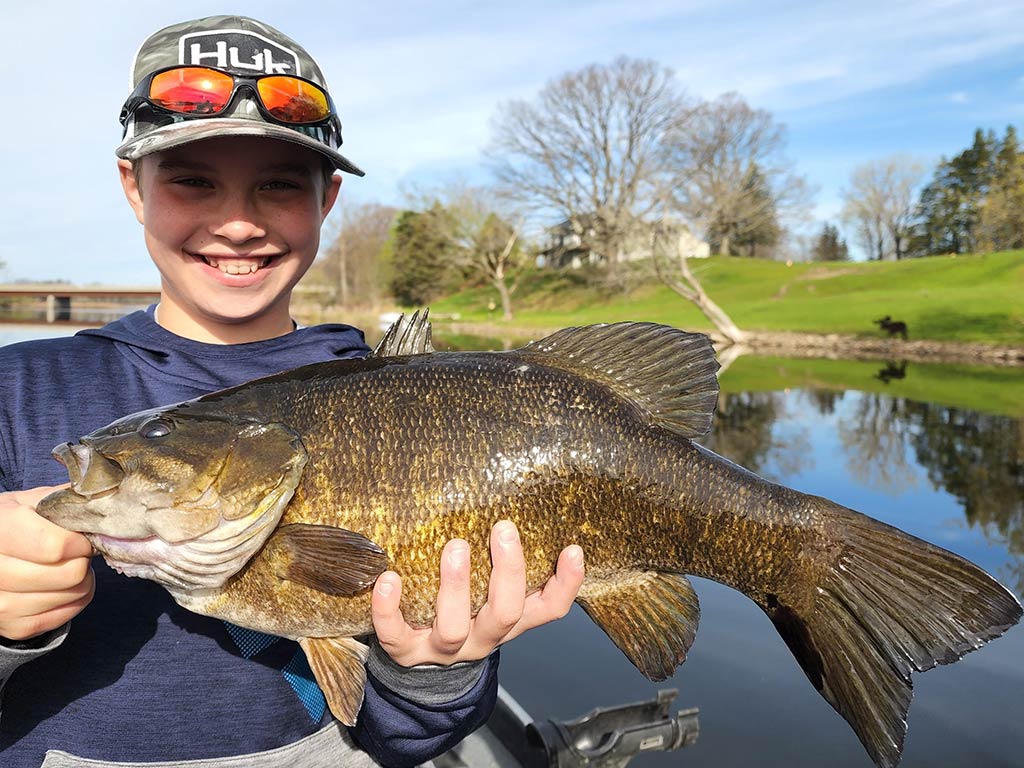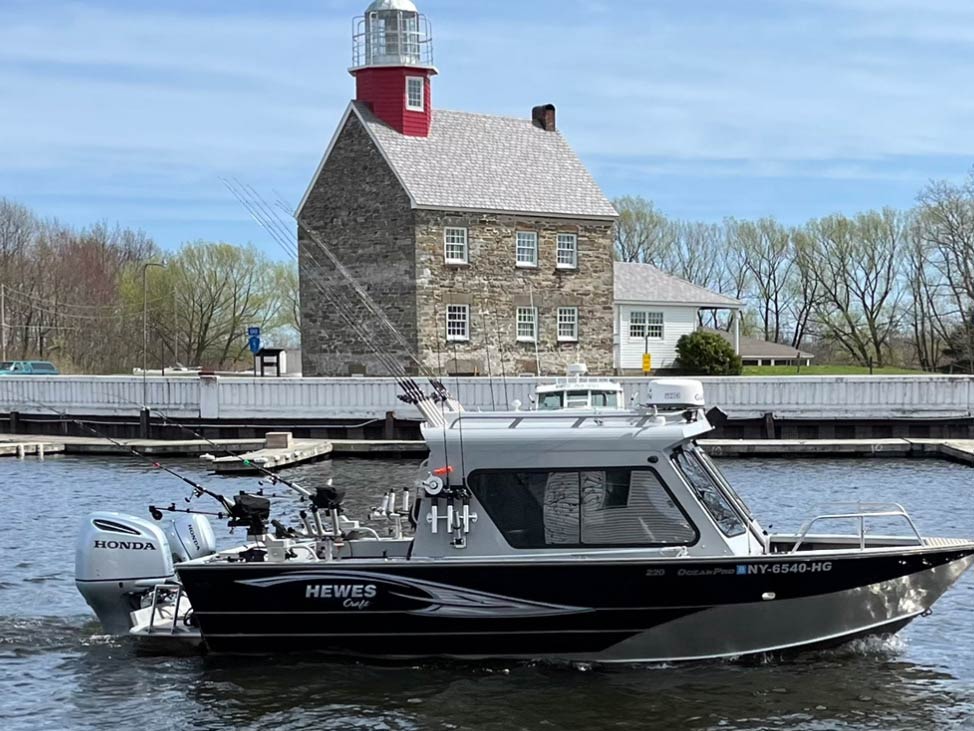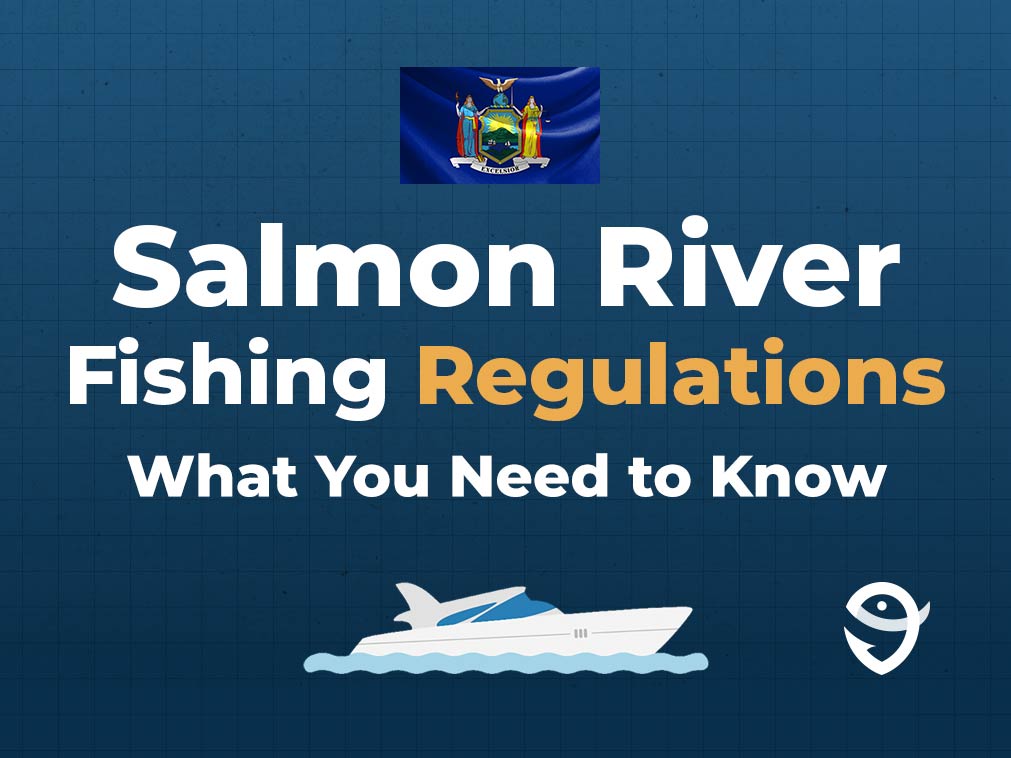We’ve all heard the saying that “size doesn’t matter” and the Salmon River is here to prove it true once again. Running just 44 miles from the Tug Hill mountains to Lake Ontario, it may seem a little underwhelming at first glance. But – to steal another cliché – don’t judge a book by its cover! Salmon River fishing is simply incredible and we’re here to tell you why.

It should come as no surprise that the angling action here is top-notch. First of all, the river is named after one of the world’s primary game fish. And there are no prizes for guessing what species you can target here! Secondly, it flows into one of the Great Lakes – some of the best freshwater fishing spots the world over.
In this guide, we’ll show you exactly what Salmon River fishing entails. We’ll talk you through the top species – beyond the river’s namesake! We’ll also introduce you to the best fishing locales, seasons, and some rules and regulations. So without further ado, let’s jump in.
What fish can I catch in the Salmon River?
We said no prizes for guessing what you can catch in this body of water. But Salmon is not all that’s on offer. True, it definitely tops the charts here, and we’ll tell you exactly why in a little bit. But there are also plenty of other prized freshwater species biting, depending on when you come. From Steelhead and Trout to a range of Bass, here are the stars of the show.
Salmon
There’s no point beating around the bush. There’s a reason this river was named after a certain species of fish, and its fishing prowess is just that. You’ll be pleased to know that not one, not two, but three species of Salmon call these waters home throughout the year, meaning there’s pretty much always a chance of finding one on the end of your line.

Chinook, Coho, and Atlantic Salmon mean that it’s worth spending a full day on the water casting your line. All three are strong fighters, but only the Atlantic variety are native to these parts. These creatures are on the smaller size, while Cohos are considerably larger, with the record in the Salmon River coming in at 33 pounds and 4 ounces.
The real superstars, however, are Chinook (also known as “King”) Salmon. Bring some heavier gear to have a shot at landing one of these brutes. All you need to know lies in the fact that the largest King ever caught in the Great Lakes region came in the Salmon River back in 1992.
Steelhead

If you’re worried about missing out on Salmon season, fear not. Salmon River Steelhead fishing is a close second to the number one spot. Just after Salmon spawn and move out of the river, Steelhead show up in great numbers, providing some of the best pound-for-pound action you could ever imagine. It may sound morbid, but Steelhead actually wait for the Salmon to leave in order to feast on their eggs! The good news for you is that egg sacks work as great bait for these fish, giving you a real advantage when trying to lure ’em.
And just like Salmon, there are multiple kinds of Steelhead that call these waters home. Skamania Steelhead come by after the spring spawning season, and stay for a couple of months through summer. Then, when Salmon lay their eggs in fall, they’re quickly followed by Washington Steelhead, who make the Salmon River their home through winter. The best action is at the start of the season when these fish are hungry. But with a bit of luck, you’ll get a Steelhead to bite whenever you come.
Brown Trout

Unlike Salmon, there’s just one member of the Trout family living in this river. Well, Steelhead is technically a Trout, but we’ll forget that for the sake of a bit of fun! They reside in 12 miles of state-run, top-grade waters – coincidentally, where the best Salmon action also takes place. Much like Steelhead, they feed on Salmon eggs, meaning they share the same seasonality and have two impressive runs, which anglers love to catch.
As for catching Brownies? Similar bait to Steelhead will do the trick, but you’ll also have good luck with plastic baits and nightcrawlers. If going out on a boat, start with flatliners and spoons at the start of the season. As the season goes on, switch up to spoons and downriggers. Of course, fly fishing is also possible, so these are real all-round fish.
Bass

As if that wasn’t enough, there are even more of the most sought-after freshwater fish available. The Salmon River’s reservoirs and lakes are chock-full of Smallmouth Bass – if you come at the right time, that is. And, if you’re lucky, their cousins – the most popular freshwater game fish in the country – Largemouth Bass – may also make an appearance. And that’s before you head out into Lake Ontario, where these creatures are plentiful!
We know these fish need no introduction, but they’re great species to go after either side of the Salmon season. You can even target them in the depths of winter when ice fishing! Despite this, their most active season is in summer – but more on that in a bit. As you’d expect, they’re prone to put up a strong fight, despite not growing to any record sizes, so you light tackle anglers get ready for some thrills.
When to Go Fishing in the Salmon River
As you may have already guessed, there’s never a bad time to fish the Salmon River. With so many of the best freshwater fish on the planet on offer, you’re in for a treat whenever you visit. That being said, not all of the fish are here at the same time. If you’re interested in finding out what’s biting right now, check out the latest Salmon River fishing reports here.
| Species | Jan | Feb | Mar | Apr | May | Jun | Jul | Aug | Sep | Oct | Nov | Dec |
|---|---|---|---|---|---|---|---|---|---|---|---|---|
| Atlantic Salmon | Weak | Weak | Weak | Weak | Fair | Good | Great | Great | Great | Great | Good | Fair |
| Brown Trout | Weak | Fair | Fair | Good | Great | Great | Great | Great | Good | Great | Good | Fair |
| Chinook Salmon | Weak | Weak | Weak | Weak | Weak | Good | Good | Great | Great | Great | Good | Weak |
| Coho Salmon | Weak | Weak | Weak | Fair | Good | Great | Fair | Weak | Good | Great | Good | Fair |
| Smallmouth Bass | Weak | Weak | Fair | Fair | Good | Good | Great | Great | Great | Good | Weak | Weak |
| Steelhead | Fair | Weak | Weak | Weak | Good | Good | Good | Good | Good | Great | Great | Good |
As you see above, Salmon show up in spring, summer, and fall. But what the table doesn’t show is just quite how good fall fishing is. Some 50% of the river’s fishing activity takes place during the Chinook fall run. Considering it only lasts about two months, the picture is pretty clear. The downside of that is that you’ll be vying for space to cast your line next to hundreds of other anglers, unless you opt for a charter or fish from private land.
Atlantic Salmon, as we’ve already mentioned, spawn a little earlier in summer, so you can get your fill under the rays of the sun. At this time, you’ll also find Bass and even some Skamania Steelhead who’ve stayed after their spring run. Of course, fall through winter is reserved for Steelhead, unless you can find a nearby frozen lake and drill a hole for Bass, Walleye, and more.
How to Go Fishing in the Salmon River
So you know about the what and when, what about the how? Every great fishing locale makes the most of what it has, and the Salmon River is no different. It’s fair to say that the NY Department of Environmental Conservation has pushed the boat out, along with local angling enthusiasts, to make all your fishing dreams come true. Here are some of the best ways to approach this body of water.
Fishing with a Guide or Charter

Without a doubt, the best way to discover the riches of the Salmon River is with a local guide. For-hire captains offer boat trips to the honey holes and there are also on-foot guides who will let you in on all the river’s secrets. If fishing on a boat, you’ll get to cover multiple spots, giving you a shot at a real mixed bag of the fish on offer here. The captain will also provide you with all the gear you need, too.
On foot, you’ll need to check whether the gear is included, but we know that all avid anglers enjoy using their own equipment anyway! With local expertise, you’ll learn all about the most effective ways to land Salmon, Steelhead, Trout, and Bass, among many other fish that call these waters home.
Solo Angling

If you’re a fan of getting back to basics, you can always head out on your own. When King Salmon season hits, especially, it won’t be difficult to head out on your own, as you can just follow the thousands of other anglers who hit up the lake’s shores in search of the ultimate reward. This does mean that the riverside gets a little crowded, but there are so many Salmon that it doesn’t really matter.
Coming out of peak season, you’ll be even more spoiled for choice. We’ll get to some of the main spots in a bit, but rest assured that anywhere between Pulaski and Altmar will be productive. As we’ve already mentioned, there’s a good chance you’ll stumble onto private property. Take a look at maps of the river to see which spots are public.
Kayak Fishing

For decades now, the Salmon River’s shallow waters have been a haven for kayakers and rafters. But in the last few years, avid anglers have been combining their passion for fishing with this thrilling sport. Enter kayak fishing on the Salmon River.
From quick-flowing, rocky streams for the experienced ‘yaker to the calm waters of the Great Lake and reservoirs, there are kayak fishing opportunities for all skills and levels. Kayak fishing guides offer trips with all the gear included or you can rent your own kayak and bring your own fishing gear. It can be tricky to maneuver a vessel while casting at the same time, so we suggest that beginners, especially, pair up with a guide.
Salmon River Fishing Spots
We’re running out of superlatives to describe this fishery by now. But there are still some things you need to know. The slow-moving and shallow waters of the Salmon River offer plenty of honey holes for you to seek out. It’s difficult to pick out the best spots, but we’ve tried. Check out our list of top fishing spots along the Salmon River.
- Pulaski. We’re starting with a big one, and deservedly so. Probably the capital of the Salmon River, Pulaski was even known as “Fishville” in the past. It’s right on the edge of the best Salmon fishing grounds, and offers Steelhead and Trout action, too. With the “Black Hole” and Douglaston Salmon Runs nearby, it’s the place to be.
- Pineville. Working our way up the river, Pineville is the heart of Steelhead country. Here, you’ll find the biggest concentration of deepwater pools that are home to plenty of these fierce beasts. And it just gets better from there…
- Altmar. There are plenty of Salmon and Steelhead hot spots between Pineville and Altmar, but once you get here, things calm down a bit. You’ll enter a fly fishing, catch-and-release-only fishery that’s up there with the best in the country – maybe the world. Just beware that fishing is closed in some sections completely from December through April.
- Salmon River Reservoir. This man-made lake is pretty much the start of the lake. It offers warm and coldwater fisheries in equal measure, meaning that the diversity of fish here is unheard of – until you hear about the final spot on the list. With Bass and Crappie options, hit the deep and vast expanses near Redfield for the best action.
- Port Ontario and the Great Lake. Okay, so we’re cheating a bit with this one, but it’s worth saying a hundred times over. There are endless opportunities available in Lake Ontario. Take the plunge, hire a guide, and go trolling to maximize your chances of landing a trophy catch.
Salmon River Fishing Regulations

Before we let you go, there are just a few key things we need to run through. We mentioned that the NY DEC was doing good work ensuring that the fishing would endure. But that’s only possible through conservation. Rules and regulations are part and parcel of ensuring a thriving fishery, and the Salmon River is no different.
Aside from two fly fishing, catch-and-release-only portions of the river, you’ll also need to be aware that only 12 miles of the river are actually maintained by the state. Any other spot is private property and you may need to pay a fee to the landowner. Other than that, there’s also a need for a NY fishing license.
Salmon River Fishing – Small Stream, Big Action

You should by now understand just how much action there is on the Salmon River. It sure punches above its weight, considering its size! Pick a spot anywhere from Lake Ontario to Tug Hill, and you can get your fill of solid fishing, along with plenty of rewarding catches. This corner of New York state really has it all.
Have you ever fished the Salmon River? Any tips or tricks to share with your fellow anglers? We’d love to hear from you in the comments below!
The post Salmon River Fishing: The Complete Guide appeared first on FishingBooker Blog.
https://ift.tt/YLHcAXx
0 Comments
Enregistrer un commentaire